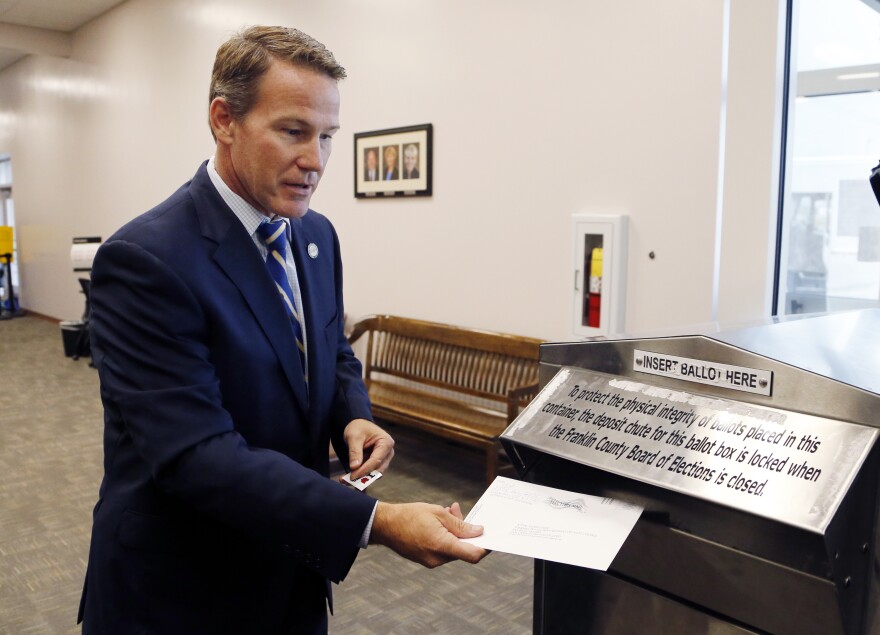More than a quarter of Ohio’s registered voters didn’t cast ballots last year, and for some of them, that could have been one inactive election too many. Ohio has been removing voters who haven’t cast ballots over a period of six years – unless they contact their Board of Elections during that time.
Larry Harmon is one of them, and now his lawsuit against Ohio is the center of a U.S. Supreme Court case expected to be argued early next year.
Harmon’s activism is the quiet kind. Until 2015, it generally took the form of deciding not to vote when he didn’t like the choices. But then the state told him his decision not to vote had cost him, at least temporarily, his right to vote.
Harmon, a software engineer and Navy veteran, protested that his decisions were constitutionally protected – and in their way, a sign of a conscientious voter.
“Sometimes, I wasn’t up on the politics,” Harmon says. “Other times I didn’t like either of the candidates. I rarely voted in the primaries. And now that I’m older, I think, ‘Geez, I should have voted in the primaries because the people in the (general) election weren’t the ones I wanted to be voting for."
Skip The Vote
In 2000, Harmon moved into the farmhouse southeast of Kent that had once been his grandparents’. During the next decade, he voted occasionally.
“I voted against Bush and against Bush and for Obama,” he says.
Then he skipped the 2012 election altogether, for a mix of personal and political reasons.
“My mother had died, and my stepfather had died, and I had gone through a period of mourning and I didn’t feel like voting,” Harmon says. “Another (reason) was, I was a little frustrated because I really liked Obama, but he couldn’t get anything done. So I thought, ‘Does it really matter who’s president if our politics is so obstructionist that you can’t get anything done?’ And to be honest I thought Mitt Romney had a couple good points.”
Still, Harmon says he never anticipated there’d be a problem when he wanted to vote again.
“I thought I’ve been a good citizen of Ohio,” he says. “I pay my taxes, I pay property taxes, I pay income taxes, I pay car-registration taxes. I get my driver’s license renewed. So I thought, ‘Geez I’m in good standing.’ And that it would be only normal to not vote sometimes.”
In 2015, he found out differently. That election, Ohio voters were being asked to approve a state constitutional amendment that would have legalized marijuana and limited production and distribution to a handful of sanctioned operators.
“I thought it was a travesty,” he says, “that they wanted to monopolize something they were calling a medicine and they wanted to tax the heck out of it.”
Harmon went to vote but couldn’t find his name in the polling book. He had to get to work at Youngstown, but fired off an email to the county Board of Elections at lunchtime. He was told he’d been purged and that he could re-register, which he did.
Off The Rolls
That missed election grated on him, though.
“When was at the school trying to find my name, I was embarrassed,” Harmon says. “I thought, ‘What did I do wrong?’ And then I found out they had just dropped me off, and then I got angry.”
Harmon followed with an email to Secretary of State Jon Husted. Husted has defended the move to clean up the rolls to account for voters who move or die. He notes that inactive voters are sent a card in the mail to tell them to contact their Boards of Elections.
Harmon says he never got the card and wonders why it isn’t sent as registered mail. He also wants to know why the state doesn’t check other public records, including property tax records.
“I thought this was un-American. I thought I had the right to vote and that I had earned the right to vote,” Harmon says. “If I don’t use my right to free speech, I don't lose it in six years. So my right to vote, why should it go away?”
The U.S. Supreme Court case centers on whether federal law allows Ohio to remove voters solely for failing to vote. Harmon is supported in his case by the ACLU and the New York-based public advocacy group Demos, which say Ohio's procedures violate the National Voting Rights Act. In addition, 12 states and the District of Columbia have submitted briefs in agreement.
A federal appeals court sided with Larry Harmon. But President Trump’s Justice Department has switched sides, and is now arguing for Ohio’s claim that the purges protect the reliability of voter rolls.





